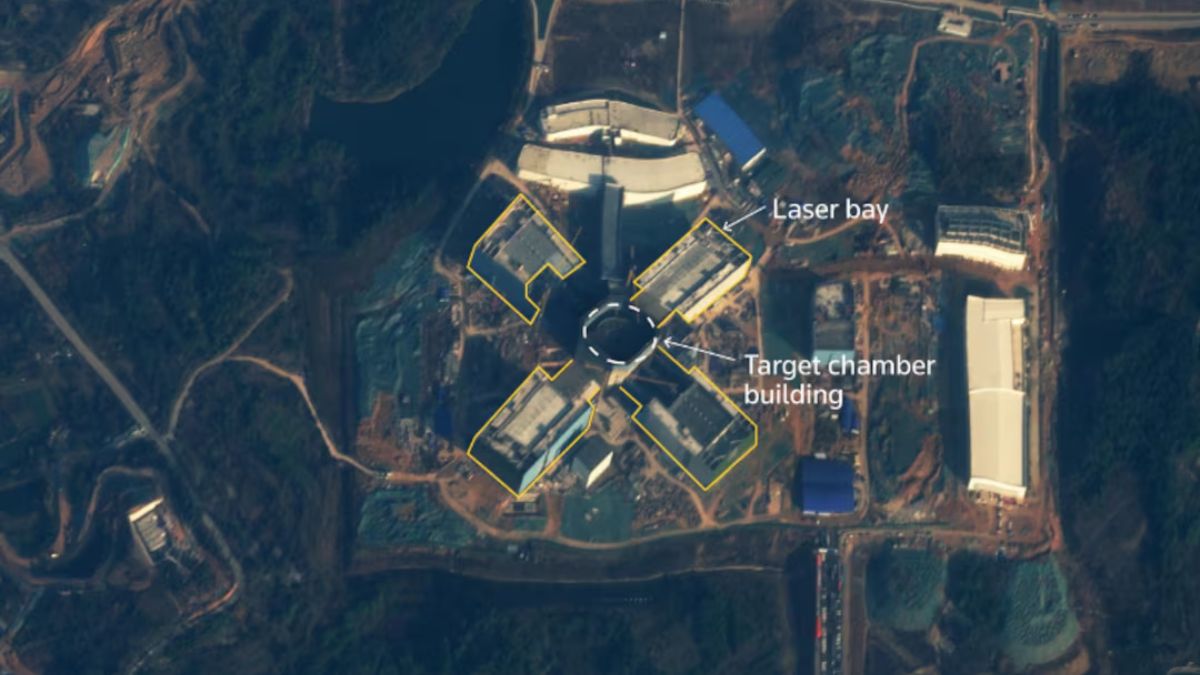China is reportedly constructing a laser-ignited fusion research centre in the southwestern city of Mianyang at a large scale. This facility could be utilised to develop nuclear weapons design and explore power generation, as per a Reuters news agency report.
Beijing has so far remained tight-lipped about building this nuclear fusion facility. The news agency’s report comes at a time when China took a big step ahead in its journey of creating a fusion-based nuclear reactor in the future after its “artificial sun” reactor achieved a sustained plasma temperature exceeding 100 million degrees Celsius for a record 1,066 seconds, roughly 18 minutes.
Should China’s nuclear capabilities be a concern for India? Let’s take a look.
China ‘building’ nuclear fusion research centre
China is building a fusion research centre similar to the US National Ignition Facility (NIF) in Northern California.
Decker Eveleth, a researcher at US-based independent research organisation CNA Corporation, told Reuters that satellite images show four outlying “arms” to house laser bays, and a central experiment bay for a target chamber holding hydrogen isotopes.
The powerful lasers will fuse these hydrogen isotopes, generating energy.
The layout of this facility is identical to the $3.5 billion US NIF. According to Eveleth, the experiment bay at the Chinese centre is about 50 per cent bigger than the one at NIF, which is currently the largest.
In 2022, scientists at the NIF announced a milestone by producing a fusion reaction that released more energy than it consumed.
US arms control envoy Marshall Billingslea revealed satellite images of China’s growth of nuclear weapons support facilities in November 2020.
It also had pictures of Mianyang showing a cleared plot of land labelled “new research or production areas since 2010”.
As per the Reuters report, this plot is the site of the fusion research centre, called the Laser Fusion Major Device Laboratory.
What it means
Researchers can study how igniting fusion fuel can one day result in generating fusion energy, a clean power source using hydrogen.
China ’s new fusion research centre does not pose a threat to the US.
Beijing has tested 45 nuclear weapons, far less than the US’ 1,054.
While nuclear explosions are banned under the Comprehensive Nuclear Test Ban Treaty, “subcritical” explosive tests and laser fusion research, known as inertial confinement fusion, are allowed. China does not have a large data set for subcritical and laser fusion experiments.
“I don’t think it would make an enormous difference. And so … I’m not concerned about China getting ahead of us in terms of their nuclear facilities,” Siegfried Hecker, former director of Los Alamos National Laboratory, a key US nuclear weapons research facility said to Reuters.
However, there is a reason to be concerned as China could use the fusion research facility to improve nuclear weapons design.
“Any country with an NIF-type facility can and probably will be increasing their confidence and improving existing weapons designs, and facilitating the design of future bomb designs without testing” the weapons themselves, William Alberque, a nuclear policy analyst at the Henry L Stimson Centre told Reuters.
ALSO READ: Explained: How the nuclear fusion breakthrough can revolutionise clean energy
Should India worry?
China has been expanding its nuclear capabilities at a greater pace than India’s.
Beijing’s arsenal surged from 410 nuclear warheads in January 2023 to an estimated 500 by January 2024. On the other hand, India’s warheads are estimated to be at 172.
By building this new nuclear fusion facility, China can fine-tune nuclear weapons designs without requiring actual tests.
This would aid Beijing in strengthening its arsenal secretly while sticking to global non-proliferation norms, as per Times of India (TOI).
China is also ahead of India in terms of nuclear power generation. While China has 55 running nuclear power reactors, India has just 23 such reactors.
China’s Shidaowan nuclear power plant, the world’s first fourth-generation reactor, has been operating since December 2023.
China is also the first country to commercialise third-generation reactors. It further has plans to develop six to eight new reactors annually.
Beijing recently took a major leap in realising its ambition to build a nuclear fusion reactor.
Nuclear fusion is the process that produces energy in the Sun and other stars.
For over 60 years, scientists have been trying to harness nuclear fusion to generate clean energy on Earth.
An experimental nuclear fusion reactor in China recently broke its own world record for maintaining super-hot plasma for 1,066 seconds, surpassing its previous record of 403 seconds in April 2023.
This is a major achievement that has taken China a step forward in building a nuclear fusion reactor in future.
With inputs from agencies


)

)
)
)
)
)
)
)
)



